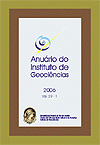The paleoautoecology of Tijubina pontei Bonfim-Júnior & Marques, 1997 (Lepidosauria, basal Squamata of Santana Formation, Aptian of Araripe Basin, Lower Cretaceous of Northwest of Brazil)
DOI:
https://doi.org/10.11137/2006_2_54-65Abstract
Tijubina pontei is a basal lizard found in the Crato Member, Santana Formation, Lower Cretaceous (Aptian), Brazil. It is considered a sister group of Huehuecuetzpalli mixtetus, the only basal lizard previously known, found in Mexico. The paleoautoecology of T. pontei is compatible with a terrestrial animal, omnivorous, which could eventually occupy other ecological niches. Based on their dentition and ecomorphology, their behaviour could be a combination of active forager or a "sit-and-wait" one. It could even perform bipedal locomotion. Comparing T. pontei with Liolaemus lutzae, an extant brazilian lizard, we find many characters and morphological similarities. This suggests that the L. lutzae habits could be extrapolated to the paleoenvironment of T. pontei which, probably, lived in a sandy habitat, with a vegetation that could support variations in salinity and high temperatures.Downloads
Download data is not yet available.
Downloads
Published
2006-01-01
How to Cite
Bonfim-Júnior, F. de C. and Rocha-Barbosa, O. (2006) “The paleoautoecology of Tijubina pontei Bonfim-Júnior & Marques, 1997 (Lepidosauria, basal Squamata of Santana Formation, Aptian of Araripe Basin, Lower Cretaceous of Northwest of Brazil)”, Anuário do Instituto de Geociências. Rio de Janeiro, BR, 29(2), pp. 54–65. doi: 10.11137/2006_2_54-65.
Issue
Section
Article
License
This journal is licensed under a Creative Commons — Attribution 4.0 International — CC BY 4.0, which permits use, distribution and reproduction in any medium, provided the original work is properly cited.















